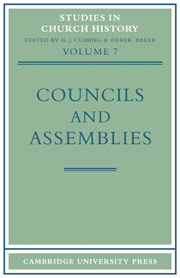Book contents
- Frontmatter
- Preface
- Contents
- Contributors
- Abbreviations
- Public welfare and social legislation in the early medieval councils (Presidential Address)
- National synods, kingship as office, and royal anointing: an early medieval syndrome
- The case of Berengar of Tours
- Ecclesiastica and Regalia: Papal investiture policy from the Council of Guastalla to the First Lateran Council, 1106–23
- Viri religiosi and the York election dispute
- Councils and synods in thirteenth-century Castile and Aragon
- The Byzantine reaction to the Second Council of Lyons, 1274
- The Council of London of 1342
- Education in English ecclesiastical legislation of the later Middle Ages
- The representation of the universitas fidelium in the councils of the conciliar period
- Nicholas Ryssheton and the Council of Pisa, 1409
- The condemnation of John Wyclif at the Council of Constance
- Some aspects of English representation at the Council of Basle
- The Council of Basle and the Second Vatican Council
- The Colloquies between Catholics and Protestants, 1539–41
- King James I's call for an ecumenical council
- John Hales and the Synod of Dort
- Assembly and Association in Dissent, 1689–1831
- The Convocation of 1710: an Anglican attempt at counter-revolution
- Laymen in synod: an aspect of the beginnings of synodical government in South Africa
- The First Vatican Council
- Kikuyu and Edinburgh: the interaction of attitudes to two conferences
Some aspects of English representation at the Council of Basle
Published online by Cambridge University Press: 12 March 2010
- Frontmatter
- Preface
- Contents
- Contributors
- Abbreviations
- Public welfare and social legislation in the early medieval councils (Presidential Address)
- National synods, kingship as office, and royal anointing: an early medieval syndrome
- The case of Berengar of Tours
- Ecclesiastica and Regalia: Papal investiture policy from the Council of Guastalla to the First Lateran Council, 1106–23
- Viri religiosi and the York election dispute
- Councils and synods in thirteenth-century Castile and Aragon
- The Byzantine reaction to the Second Council of Lyons, 1274
- The Council of London of 1342
- Education in English ecclesiastical legislation of the later Middle Ages
- The representation of the universitas fidelium in the councils of the conciliar period
- Nicholas Ryssheton and the Council of Pisa, 1409
- The condemnation of John Wyclif at the Council of Constance
- Some aspects of English representation at the Council of Basle
- The Council of Basle and the Second Vatican Council
- The Colloquies between Catholics and Protestants, 1539–41
- King James I's call for an ecumenical council
- John Hales and the Synod of Dort
- Assembly and Association in Dissent, 1689–1831
- The Convocation of 1710: an Anglican attempt at counter-revolution
- Laymen in synod: an aspect of the beginnings of synodical government in South Africa
- The First Vatican Council
- Kikuyu and Edinburgh: the interaction of attitudes to two conferences
Summary
In several papers already published I have attempted to provide an account of English relations with the Council of Basle and of the English role within the Council; in the course of these studies I have also tried to identify as many as possible of the Englishmen who can be traced at Basle during this period. There is room, however, for a few further observations, and I trust that these will prove a useful supplement to my earlier work.
Of the two delegations that went to the Council from England, the first arrived early in 1433 and stayed only a few months, the second went in 1434 and was present for about a year until mid-1435. Both were despatched from England as the result of missions from the Council to this country led by Gerardo Landriani, the Bishop of Lodi. On each occasion the king's council resolved to send representatives to Basle and the Convocation of Canterbury then decided likewise. The members of the first delegation were active in Basle, but they did not formally join the Council since they declined to take the oath of incorporation by which entrants to the Council submitted to its authority and discipline. They were admitted to the discussions about the four Hussite articles of faith, perhaps because the Hussites had also refused to be incorporated. A further instalment of the delegation was planned but never sent. The members of the second delegation were allowed to take a modified form of the oath and some of them participated in the Council's work.
- Type
- Chapter
- Information
- Councils and Assemblies , pp. 219 - 228Publisher: Cambridge University PressPrint publication year: 1970



